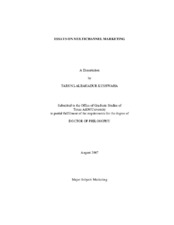| dc.description.abstract | Multichannel marketing is the practice of simultaneously offering information, goods, services, and support to customers through two or more synchronized channels. In this dissertation, I develop an integrated framework of multichannel marketing and develop models to assist managers in their marketing resource allocation decisions. In the first essay of the dissertation, I investigate the factors that drive customers multichannel shopping behavior and identify its consequences for retailers. In the second essay, I build on this work and develop a model that enables firms to optimize their allocation of marketing resources across different customer-channel segments. In the first essay, I develop a framework comprising the factors that drive consumers’ channel choice, the consequences of channel choice, and their implications for managing channel equity. The results show that customer-channel choice is driven in a nonlinear fashion by a customer demographic variable such as age and is also influenced by consumer shopping traits such as number of categories bought and the duration of relationship with a retailer. I show that by controlling for the moderating effects of channel-category associations, the influence of customers’ demographics and shopping traits on their channel choices can vary significantly across product categories. Importantly, the results show that multichannel shoppers buy more often, buy more items, and spend considerably more than single channel shoppers. The channel equity of multichannel customers is nearly twice that of the closest single channel customers (online or offline). In the second essay, I propose a model for optimal allocation of marketing efforts across multiple customer-channel segments. I first develop a set of models for consumer response to marketing efforts for each channel-customer segment. This set comprises four models, the first for purchase frequency, the second for purchase quantity, the third for product return behavior, and the fourth for contribution margin of purchase. The results show that customers’ responses to firm marketing efforts vary significantly across the customer-channel segments. They also suggest that marketing efforts influence purchase frequency, purchase quantity and monetary value in different ways. The resource allocation results show that profits can be substantially improved by reallocating marketing efforts across the different customer-channel segments. | en |


